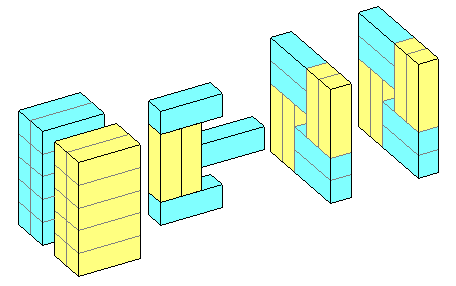Solution to Problem #5
Gary Stafford of Southwest Missouri State University solved the
4×4×4 case. Ignacio Larrosa Cańestro of Coruńa (Spain), Ryan
Moats of Omaha NE, Al Zimmermann of White Plains NY, Jim Ferry of the
University of Illinois, Chuck Tiberio of Wellesley MA, Philippe
Fondanaiche of Paris (France), Shawn Poindexter a physics major at
Southwest Missouri State University, Matt Hudelson of Washington State
University, Matthew Brom of Walnut Grove High School MO, and Vince Lynch
of Doncaster (UK) found solutions to both cases. Here is Jim Ferry's
solution, followed by 3D renderings courtesy of Al Zimmermann:
Label the unit cubes of the 4×4×4 cube (0,0,0), (0,0,1), ..., (3,3,3).
The sum of all the cube-labels is (96,96,96) = (0,0,0) mod 3. The sum of
the cube-labels over any 3×1×1 box must be (0,0,0) mod 3, so the removed
cube's label must also be (0,0,0) mod 3: i.e., the removed cube must be
a corner.
There is an obvious solution in this case, based on the partition
4×4×4 -> 3×4×4 + (1×4×4 -> 1×3×4 + (1×1×4 -> 1×1×3 + 1×1×1)).
For the 5×5×5 case, label the unit cubes (0,0,0) through (4,4,4).
The sum of all the cube-labels is (250,250,250) = (1,1,1) mod 3, so,
letting (x1,y1,z1) and (x2,y2,z2) be the labels of the removed unit
cubes, we have
(1) (x1,y1,z1) + (x2,y2,z2) = (1,1,1) mod 3.
Next, consider the sum of the components of the labels mod 3 for
a unit cube. The number of unit cubes for which this quantity is
0, 1, and 2, is 41, 42, and 42, respectively. Any 3×1×1 box has
one unit cube of each type, so the value of the quantity for the
removed cubes must be 1 for one, and 2 for the other:
(2) x1 + y1 + z1 = 1 mod 3,
x2 + y2 + z2 = 2 mod 3.
Finally, note that each cube label coordinate (0 through 4) occurs
75 times altogether. The values of these mod 3 occur 150, 150, and
75 for 0, 1, and 2 respectively. However, each value (mod 3) occurs
3n + 1 times in a 3×1×1 box, so for all 41 (= 2 mod 3) boxes, each
value occurs 3n' + 2 times. Therefore, among the six values in the
removed unit cubes, each value must occur 3m + 1 times. Thus, one
value occurs 4 times, and the other two once.
The value v that occurs 4 times cannot appear in one removed unit cube
only: this would make x1 + y1 + z1 (or x2 + y2 + z2) = 0 mod 3,
which contradicts (2). Thus, it must occur exactly twice for each
removed cube. For some coordinate (x-, y-, or z-) the value v must
therefore appear in each removed unit cube, so, by (1), 2v = 1 mod 3,
whence v = 2. Let, w.l.o.g., x1 = x2 = y1 = 2, then y2 = 2, z1 = 1,
and z2 = 0. I.e., the labels of the removed cubes must (up to symmetry)
be
{(2,2,0),(2,2,1)} mod 3.
The removed cubes must lie in the central, 5×1×1 box. There are
three cases that can occur (for where the removed cubes, denoted "x",
lie in this 5×1×1 box):
(a) xooox
(b) xxooo
(c) oxoxo
It is easy to construct solutions for cases (a) and (b): just fill
in the o's with a 3×1×1 box. There remain 5 identical punctured squares,
which are easy to fill in by partitioning into 4 3×2 boxes.
For case (c), add boxes thusly:
ooAoo
ooAoo
BxAxC
BDDDC
BEEEC
There remain 2 punctured planes that can be filled as in case (a-b), and
2 5×2×3 boxes which are filled in trivially.



Back to the Archives
Back to the Math Department Homepage.



